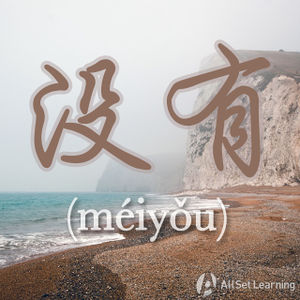Difference between revisions of "Expressing comparable degree with "you""
| Line 37: | Line 37: | ||
=== Structure === | === Structure === | ||
| − | |||
| − | |||
<div class="jiegou"> | <div class="jiegou"> | ||
| − | Subj. + 有 + 多 + 大 / 高 | + | Subj. + 有 + 多 + 大 / 高 / 长 / 重 ? |
| − | |||
| − | |||
| − | |||
| − | |||
| − | |||
| − | |||
| − | |||
| − | |||
| − | |||
| − | |||
| − | |||
| − | |||
</div> | </div> | ||
=== Examples === | === Examples === | ||
| − | |||
| − | |||
| − | |||
| − | |||
<div class="liju"> | <div class="liju"> | ||
*你 家 <em>有</em> 多 大 ? <span class="pinyin">Nǐ jiā <em>yǒu</em> duō dà ?</span><span class="trans">How big is your house?</span> | *你 家 <em>有</em> 多 大 ? <span class="pinyin">Nǐ jiā <em>yǒu</em> duō dà ?</span><span class="trans">How big is your house?</span> | ||
*我 家 <em>有</em> 一百 三十 平 。<span class="pinyin">Wǒ jiā <em>yǒu</em> yī bǎi sānshí píng.</span><span class="trans">My house is 130 square meters.</span> | *我 家 <em>有</em> 一百 三十 平 。<span class="pinyin">Wǒ jiā <em>yǒu</em> yī bǎi sānshí píng.</span><span class="trans">My house is 130 square meters.</span> | ||
| − | |||
| − | |||
| − | |||
| − | |||
| − | |||
</div> | </div> | ||
<div class="liju"> | <div class="liju"> | ||
*他 <em>有</em> 多 高 ?<span class="pinyin">Tā <em>yǒu</em> duō gāo?</span><span class="trans">How tall is he?</span> | *他 <em>有</em> 多 高 ?<span class="pinyin">Tā <em>yǒu</em> duō gāo?</span><span class="trans">How tall is he?</span> | ||
| − | *他 <em>有</em> | + | *他 <em>有</em> 一 米 九 。<span class="pinyin">Tā <em>yǒu</em> yī mǐ jiǔ.</span><span class="trans">His height is 1.9 meter.</span> |
</div> | </div> | ||
<div class="liju"> | <div class="liju"> | ||
| − | *这 | + | *这 条 河 多 长 ?<span class="pinyin">Zhè tiáo hé <em>yǒu</em> duō cháng?</span><span class="trans">How long is this river?</span> |
| − | *这 | + | *这 条 河 五 百 多 公里(长)。<span class="pinyin">Zhè tiáo hé <em>yǒu</em> wǔ bǎi duō gōnglǐ (cháng).</span><span class="trans">This river is five hundred kilometers long.</span> |
</div> | </div> | ||
<div class="liju"> | <div class="liju"> | ||
| − | *他 | + | *他 多 重 ?<span class="pinyin">Tā <em> yǒu</em> duō zhòng?</span><span class="trans">How much does he weigh?</span> |
| − | *这个 孩子 才 十 岁,已经 | + | *这个 孩子 才 十 岁,已经 150 斤 了 。<span class="expl">One "jin" = 500g</span><span class="pinyin">Zhège háizi cái shí suì, yǐjīng yī bǎi wǔshí jīn le.</span><span class="trans">This kid is only ten, but he's already 150 jin.</span> |
</div> | </div> | ||
Revision as of 07:31, 21 December 2017
-
Level
-
Similar to
-
Used for
-
Keywords
有 (yǒu), besides just meaning "to have," can also be used in comparisons. It's what you use instead of 比 (bǐ) if something is "as [Adj.] as" something else.
Contents
Used for Comparison
The structure is very straightforward. It literally means "A has B's [Adj.]." The meaning is "A is as [Adj.] as B." This pattern is often used in questions.
Structure
A + 有 + B + Adj. + 吗 ?
This form is often used with 那么, which in this case means "as much." And it indicates that B is already very [Adj.]. When B is absent, 那么 mean "so" or "that".
A + 有 (+ B) + 那么 + Adj. + 吗 ?
Examples
- 他 有 我 帅 吗 ?Is he as handsome as me?
- 泰国 有 日本 好玩 吗 ?Is Thailand as fun as Japan?
- 你 家 有 他 家 有钱 吗 ?Is your family as rich as his family is?
- 你 的 工资 有 那么 高 吗 ?Is your salary that high?
- 他 有 那么 厉害 吗 ?Is he that difficult to deal with?
Used for Description
Notice that all these example sentences are questions. This form can also be used in simple statements. Note that 描述人身高、体重或空间大小时,用数字加相应的计量单位,如"米、公斤、平方米"即可,不用加"高、重、大"。
Structure
Subj. + 有 + 多 + 大 / 高 / 长 / 重 ?
Examples
- 你 家 有 多 大 ? How big is your house?
- 我 家 有 一百 三十 平 。My house is 130 square meters.
- 他 有 多 高 ?How tall is he?
- 他 有 一 米 九 。His height is 1.9 meter.
- 这 条 河 多 长 ?How long is this river?
- 这 条 河 五 百 多 公里(长)。This river is five hundred kilometers long.
- 他 多 重 ?How much does he weigh?
- 这个 孩子 才 十 岁,已经 150 斤 了 。One "jin" = 500gThis kid is only ten, but he's already 150 jin.
See also
- Basic comparisons with "meiyou"
- Basic comparisons with "bi"
- Basic comparisons with "bu bi"
- Comparisons with "buru"
- Basic comparisons with "yiyang"
Sources and further reading
Books
- New Practical Chinese Reader 3 (新实用汉语课本3) (pp. 33-4) Anything Goes (无所不谈) →buy
- 现代汉语八百词 (pp. 631) 卓越汉语-公司实战篇 →buy



